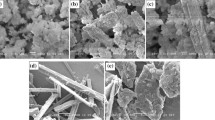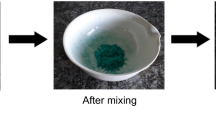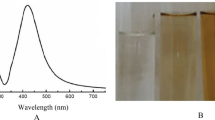Abstract
With advancements in architectural coatings, the demand for antimicrobial coatings in this sector has increased significantly. The COVID-19 pandemic has also been a primary force behind the increased demand for and production of antimicrobial coatings. Typically, antimicrobial coatings are used to resist and decolonize microbial attacks such as biofilm formation, fungal contamination, and black mold formation. In this study, we synthesized a water-based antimicrobial polymer nanocomposite, I-P(MMA/BA), by blending an iodine complex with a poly (methyl methacrylate-butyl acrylate) latex with the aid of polyol and polyvinylpyrrolidone. Antimicrobial efficacy was evaluated in two habitats, namely planktonic and biofilm. Biomass studies indicated that iodinated latex nanocomposites and films show excellent antibacterial and antibiofilm activities. About 85–97% of biofilm formation was reduced by covering 15–30% of the area with iodinated latex film. The contact angle measurement of the iodinated latex-coated surface provides evidence of good hydrophobicity, which prevents stagnation of water over the surface. The developed dual-functional water-based iodinated nanocomposite displays great potential for inhibiting biofilm formation on surfaces when employed as a binder in paints.











Similar content being viewed by others
Data availability
All data generated or analyzed during this study are included in this published article.
References
Machado Querido, M, Paulo, I, Hariharakrishnan, S, Rocha, D, Barbosa, N, Galhano, R, Santos, D, Moura Bordado, J, Teixeira, JP, Pereira, CC, Borges, P, Simões, M, Maresca, M, “Self-Disinfecting Paints with the Natural Antimicrobial Substances: Colophony and Curcumin.” Antibiotics, https://doi.org/10.3390/antibiotics10111351 (2021)
Wu, S, Wang, Y, Jin, X, Tian, J, Liu, J, Mao, Y, “Environmental Contamination by SARS-CoV-2 in a Designated Hospital for Coronavirus Disease 2019.” Am. J. Infect. Control, 48 (8) 910–914. https://doi.org/10.1016/J.AJIC.2020.05.003 (2020)
Cloutier, M, Mantovani, D, Rosei, F, “Antibacterial Coatings: Challenges, Perspectives, and Opportunities.” Trends Biotechnol., 33 (11) 637–652. https://doi.org/10.1016/J.TIBTECH.2015.09.002 (2015)
Yao, H, Li, L, Li, W, Qi, D, Fu, W, Wang, N, “Application of Nanomaterials in Waterborne Coatings: A Review.” Resour. Chem. Mater., 1 (2) 184–200. https://doi.org/10.1016/J.RECM.2022.06.004 (2022)
Dileep, P, Jacob, S, Narayanankutty, SK, “Functionalized Nanosilica as an Antimicrobial Additive for Waterborne Paints.” Prog. Org. Coat., 142 105574 (2020)
Nevalainen, A, Täubel, M, Hyvärinen, A, “Indoor Fungi: Companions and Contaminants.” Indoor Air, 25 (2) 125–156. https://doi.org/10.1111/INA.12182 (2015)
Jayaprakash, B, Adams, RI, Kirjavainen, P, Karvonen, A, Vepsäläinen, A, Valkonen, M, Järvi, K, Sulyok, M, Pekkanen, J, Hyvärinen, A, Täubel, M, “Indoor Microbiota in Severely Moisture Damaged Homes and the Impact of Interventions.” Microbiome, 5 (1) 138. https://doi.org/10.1186/S40168-017-0356-5/TABLES/6 (2017)
Kportufe, GS, “The Devastating Effects of Rising Damp in the Construction Industry.” Indus. Eng. Lett., 5(10) 28–35 (2015)
Dannemiller, KC, Weschler, CJ, Peccia, J, “Fungal and Bacterial Growth in Floor Dust at Elevated Relative Humidity Levels.” Indoor Air, 27 (2) 354–363. https://doi.org/10.1111/INA.12313 (2017)
Gupta, S, Puttaiahgowda, YM, Nagaraja, A, Jalageri, MD, “Antimicrobial Polymeric Paints: An Up-to-Date Review.” Polym. Adv. Technol., 32 (12) 4642–4662. https://doi.org/10.1002/PAT.5485 (2021)
Burkhardt, M, Zuleeg, S, Vonbank, R, Schmid, P, Hean, S, Lamani, X, Bester, K, Boller, M, “Leaching of Additives from Construction Materials to Urban Storm Water Runoff.” Water Sci. Technol., 63 (9) 1974–1982. https://doi.org/10.2166/WST.2011.128 (2011)
Nazar, FN, Weerasinghe, TK, Perera, S, “A Preliminary Study on the Resistance of Paints Against the Growth of Algae and Fungi.” Adv. Mat. Res., 746 186–191. https://doi.org/10.4028/WWW.SCIENTIFIC.NET/AMR.746.186 (2013)
Machado Querido, M, Paulo, I, Hariharakrishnan, S, Rocha, D, Barbosa, N, Galhano, R, Santos, D, Moura Bordado, J, Teixeira, JP, Pereira, CC, Borges, P, Simões, M, Maresca, M, “Self-Disinfecting Paints with the Natural Antimicrobial Substances: Colophony and Curcumin.” Antibiotics, https://doi.org/10.3390/antibiotics10111351 (2021)
Jämsä, S, Mahlberg, R, Holopainen, U, Ropponen, J, Savolainen, A, Ritschkoff, AC, “Slow Release of a Biocidal Agent from Polymeric Microcapsules for Preventing Biodeterioration.” Prog. Org. Coat., 76 (1) 269–276. https://doi.org/10.1016/J.PORGCOAT.2012.09.018 (2013)
Machado Querido, M, Paulo, I, Hariharakrishnan, S, Rocha, D, Barbosa, N, Gonçalves, D, Galhano, R, Santos, D, Moura Bordado, J, Teixeira, JP, Pereira, CC, “Development and In Vitro Validation of Antibacterial Paints Containing Chloroxylenol and Terpineol.” Toxics, https://doi.org/10.3390/toxics10070343 (2022)
Munita, JM, Arias, CA, “Mechanisms of Antibiotic Resistance.” Microbiol. Spectr., 4 (2) 464–472. https://doi.org/10.1128/MICROBIOLSPEC.VMBF-0016-2015 (2016)
Sun, G, Ge, H, Luo, J, Liu, R, “Highly Wear-Resistant UV-Curing Antibacterial Coatings via Nanoparticle Self-Migration to the Top Surface.” Prog. Org. Coat., 135 19–26. https://doi.org/10.1016/J.PORGCOAT.2019.05.018 (2019)
MacMullen, J, Zhang, Z, Dhakal, HN, Radulovic, J, Karabela, A, Tozzi, G, Hannant, S, Alshehri, MA, Buhé, V, Herodotou, C, Totomis, M, Bennett, N, “Silver Nanoparticulate Enhanced Aqueous Silane/Siloxane Exterior Facade Emulsions and Their Efficacy Against Algae and Cyanobacteria Biofouling.” Int. Biodeterior. Biodegrad., 93 54–62. https://doi.org/10.1016/J.IBIOD.2014.05.009 (2014)
Ghorbani, HR, “Biological and Non-Biological Methods for Fabrication of Copper Nanoparticles.” Chem. Eng. Commun., 202 (11) 1463–1467. https://doi.org/10.1080/00986445.2014.950732 (2015)
Ghorbani, HR, “Biological Coating of Paper Using Silver Nanoparticles.” IET Nanobiotechnol., 8 (4) 263–266. https://doi.org/10.1049/IET-NBT.2013.0039 (2014)
Hamid, RG, Saeid, S, “Antibacterial Effects of Silver Nanoparticles on Escherichia coli and Bacillus subtilis.” Oriental J. Chem., 31 341–344 (2015)
Ghorbani, HR, Molaei, M, “Optimization of Coating Solution for Preparation of Antibacterial Copper-Polyethylene Nanocomposite.” Mater. Res. Exp., 4 (6) 065017 (2017)
Ghorbani, HR, Molaei, M, “Antibacterial Nanocomposite Preparation of Polypropylene-Silver Using Corona Discharge.” Prog. Org. Coat., 112 187–190. https://doi.org/10.1016/J.PORGCOAT.2017.07.020 (2017)
Tornero, ACF, Blasco, MG, Azqueta, MC, Acevedo, CF, Castro, CS, López, SJR, “Antimicrobial Ecological Waterborne Paint Based on Novel Hybrid Nanoparticles of Zinc Oxide Partially Coated with Silver.” Prog. Org. Coat., 121 130–141. https://doi.org/10.1016/J.PORGCOAT.2018.04.018 (2018)
Chen, MC, Koh, PW, Ponnusamy, VK, Lee, SL, “Titanium Dioxide and Other Nanomaterials Based Antimicrobial Additives in Functional Paints and Coatings: Review.” Prog. Org. Coat., https://doi.org/10.1016/J.PORGCOAT.2021.106660 (2022)
Liao, C, Li, Y, Tjong, SC, “Bactericidal and Cytotoxic Properties of Silver Nanoparticles.” Int. J. Mol. Sci., https://doi.org/10.3390/IJMS20020449 (2019)
Priimagi, A, Cavallo, G, Metrangolo, P, Resnati, G, “The Halogen Bond in the Design of Functional Supramolecular Materials: Recent Advances.” Acc Chem. Res., 46 (11) 2686–2695. https://doi.org/10.1021/AR400103R/ASSET/IMAGES/LARGE/AR-2013-00103R_0009.JPEG (2013)
Leaper, DJ, Schultz, G, Carville, K, Fletcher, J, Swanson, T, Drake, R, “Extending the TIME Concept: What Have We Learned in the Past 10 Years?” Int. Wound J., https://doi.org/10.1111/J.1742-481X.2012.01097.X (2012)
Moulay, S, “Molecular Iodine/Polymer Complexes.” J. Polym. Eng., 33 (5) 389–443. https://doi.org/10.1515/POLYENG-2012-0122/ASSET/GRAPHIC/POLYENG-2012-0122_FIG43.JPG (2013)
Tyagi, M, Singh, S, Singh, H, “Iodinated Natural Rubber Latex: Preparation, Characterisation and Antibacterial Activity Assessment.” Artif. Cells Blood Substit. Immobil. Biotechnol., 28 (6) 521–533. https://doi.org/10.1080/10731190009139268 (2000)
Jie, L, Ying, D, Yuyu, S, “Antimicrobial Activity and Biocompatibility of Polyurethaneg-Iodine Complexes.” J. Bioact. Compat. Polym., 25 (2) 185–206. https://doi.org/10.1177/0883911509359980 (2010)
Hassan, I, Keen, A, “Potassium Iodide in Dermatology.” Indian J. Dermatol. Venereol. Leprol., 78 (3) 390. https://doi.org/10.4103/0378-6323.95472 (2012)
Makhayeva, DN, Irmukhametova, GS, Khutoryanskiy, VV, “Polymeric Iodophors: Preparation, Properties, and Biomedical Applications.” Rev. J. Chem., 10 (1) 40. https://doi.org/10.1134/S2079978020010033 (2020)
Chauret, CP, “Sanitization." In: Encyclopedia of Food Microbiology: Second Edition 2014, 360–364. https://doi.org/10.1016/B978-0-12-384730-0.00407-9.
Lepelletier, D, Maillard, JY, Pozzetto, B, Simon, A, “Povidone Iodine: Properties, Mechanisms of Action, and Role in Infection Control and Staphylococcus aureus Decolonization.” Antimicrob. Agents Chemother., https://doi.org/10.1128/AAC.00682-20 (2020)
Schreier, H, Erdos, G, Reimer, K, König, B, König, W, Fleischer, W, “Molecular Effects of Povidone-Iodine on Relevant Microorganisms: An Electron-Microscopic and Biochemical Study.” Dermatology, https://doi.org/10.1159/000246043 (1997)
Cooper, RA, “Iodine Revisited.” Int. Wound J., 4 (2) 124. https://doi.org/10.1111/J.1742-481X.2007.00314.X (2007)
Mcdonnell, G, Russell, AD, “Antiseptics and Disinfectants: Activity, Action, And.” Clin. Microbiol. Rev., 12 (1) 147. https://doi.org/10.1128/CMR.12.1.147 (1999)
Tigli, RS, Evren, V, “Synthesis and Characterization of Pure Poly(Acrylate) Latexes.” Prog. Org. Coat., 52 (2) 144–150. https://doi.org/10.1016/J.PORGCOAT.2004.10.004 (2005)
Shukla, SK, Hariharan, S, Rao, TS, “Uranium Bioremediation by Acid Phosphatase Activity of Staphylococcus aureus Biofilms: Can a Foe Turn a Friend?” J. Hazard. Mater., 384 121316. https://doi.org/10.1016/J.JHAZMAT.2019.121316 (2020)
Cunliffe, AJ, Askew, PD, Stephan, I, Iredale, G, Cosemans, P, Simmons, LM, Verran, J, Redfern, J, “How Do We Determine the Efficacy of an Antibacterial Surface? A Review of Standardised Antibacterial Material Testing Methods.” Antibiotics, https://doi.org/10.3390/ANTIBIOTICS10091069 (2021)
Smith, K, Hunter, IS, “Efficacy of Common Hospital Biocides with Biofilms of Multi-Drug Resistant Clinical Isolates.” J. Med. Microbiol., 57 (8) 966–973. https://doi.org/10.1099/JMM.0.47668-0 (2008)
Eqbal, MD, Naaz, F, Sharma, K, Gundabala, V, “Microfluidics-Based Generation of Cell Encapsulated Microbeads in the Presence of Electric Fields and Spatio-Temporal Viability Studies.” Colloids Surf. B Biointerfaces,. https://doi.org/10.1016/J.COLSURFB.2021.112065 (2021)
Holman, BWB, Diffey, SM, Logan, BG, Mortimer, SI, Hopkins, DL, “Nix Pro Color Sensor Comparison to HunterLab MiniScan for Measuring Lamb Meat Colour and Investigation of Repeat Measures, Illuminant and Standard Observer Effects.” Food Anal. Methods, 14 (4) 697–705. https://doi.org/10.1007/S12161-020-01914-0 (2021)
Osol, A, Pines, CC, “Solubility of Iodine in Glycol-Water Solutions*.” J. Am. Pharm. Assoc. (Scientific ed.), 41 (12) 634–637. https://doi.org/10.1002/JPS.3030411203 (1952)
Patra, R, Raju, KRCS, Bhaskar, B, Sarkar, D, Chaudhuri, S, Garg, P, Subasri, R, “Biofilm Inhibiting Nanocomposite Coatings—A Promising Alternative to Combat Surgical Site Infections.” J. Coat. Technol. Res., 19 (6) 1697–1711. https://doi.org/10.1007/S11998-022-00642-W/FIGURES/6 (2022)
Mokrzycki Cardinal Stefan, W, Tatol, M, “Color Difference Delta E-A Survey Colour Difference ∆E-A Survey.”
Novak Babič, M, Gostinčar, C, Gunde-Cimerman, N, "Microorganisms Populating the Water-Related Indoor Biome." Appl. Microbio. Biotechnol., 104 6443–6462. https://doi.org/10.1007/s00253-020-10719-4/Published (2020)
Acknowledgments
All authors would like to acknowledge IRCC, IIT Bombay, for BIO-AFM (BSBE), Prof. Amit Arora for Hunter Lab color meter (CTARA) and Prof. Jyoti Seth for providing contact angle measurement facilities (PG Lab Facilities, Chemical Engineering).
Funding
H.S. acknowledges financial assistance from the Prime Minister Research Fellowship (PMRF) funding resource, and V.G. acknowledges financial assistance from Science and Engineering Research Board (SERB), Grant # CR/2021/000762.
Author information
Authors and Affiliations
Contributions
H.S. was responsible for data curation, formal analysis, methodology, writing—original draft and writing—reviewing and editing. M.S.T. contributed to investigation and supervision. V.G. was involved in conceptualization, funding acquisition, investigation and supervision. All authors have given approval to the final version of the manuscript.
Corresponding author
Ethics declarations
Conflict of interest
The authors declare that they have no relevant financial or nonfinancial interests to disclose and no competing interests to declare.
Additional information
Publisher's Note
Springer Nature remains neutral with regard to jurisdictional claims in published maps and institutional affiliations.
Supplementary Information
Below is the link to the electronic supplementary material.
Rights and permissions
Springer Nature or its licensor (e.g. a society or other partner) holds exclusive rights to this article under a publishing agreement with the author(s) or other rightsholder(s); author self-archiving of the accepted manuscript version of this article is solely governed by the terms of such publishing agreement and applicable law.
About this article
Cite this article
Sekar, H., Tirumkudulu, M.S. & Gundabala, V. Development of antibacterial waterborne polymeric coating using iodine complex. J Coat Technol Res 21, 773–787 (2024). https://doi.org/10.1007/s11998-023-00856-6
Received:
Revised:
Accepted:
Published:
Issue Date:
DOI: https://doi.org/10.1007/s11998-023-00856-6




